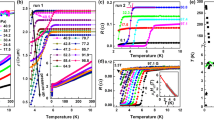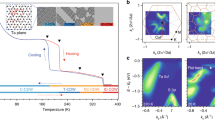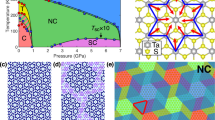Abstract
The search for the coexistence between superconductivity and other collective electronic states in many instances promoted the discovery of novel states of matter. The manner in which the different types of electronic order combine remains an ongoing puzzle. 1T-TaS2 is a layered material, and the only transition-metal dichalcogenide (TMD) known to develop the Mott phase. Here, we show the appearance of a series of low-temperature electronic states in 1T-TaS2 with pressure: the Mott phase melts into a textured charge-density wave (CDW); superconductivity develops within the CDW state, and survives to very high pressures, insensitive to subsequent disappearance of the CDW state and, surprisingly, also the strong changes in the normal state. This is also the first reported case of superconductivity in a pristine 1T-TMD compound. We demonstrate that superconductivity first develops within the state marked by a commensurability-driven, Coulombically frustrated, electronic phase separation.
This is a preview of subscription content, access via your institution
Access options
Subscribe to this journal
Receive 12 print issues and online access
$259.00 per year
only $21.58 per issue
Buy this article
- Purchase on Springer Link
- Instant access to full article PDF
Prices may be subject to local taxes which are calculated during checkout





Similar content being viewed by others
References
Bednorz, J. G. & Müller, K. A. Possible high Tc superconductivity in the Ba–La–Cu–O system. Zeitschrift für Physik B 64, 189–193 (1986).
Lee, P. A., Nagaosa, N. & Wen, X.-G. Doping a Mott insulator: Physics of high-temperature superconductivity. Rev. Mod. Phys. 78, 17–76 (2006).
Carlson, E., Emery, V., Kiveslon, S. & Ograd, D. The Physics of Conventional and Unconventional Superconductors (Springer, 2003).
Gabovich, A. M., Voitenko, A. I., Annett, J. F. & Ausloos, M. Charge- and spin-density wave superconductors. Supercond. Sci. Tech. 14, R1–R27 (2001).
Grosche, F. M. et al. Superconductivity on the threshold of magnetism in CePd2Si2 and CeIn3 . J. Phys. Condens. Matter 13, 2845–2860 (2001).
Takada, K. et al. Superconductivity in two-dimensional CoO2 layers. Nature 422, 53–55 (2003).
Morosan, E. et al. Superconductivity in CuxTiSe2 . Nature Phys. 2, 544–550 (2006).
Friend, R. H. & Yoffe, A. D. Electronic properties of intercalation complexes of the transition metal dichalcogenides. Adv. Phys. 36, 1–94 (1987).
Wilson, J. A., Di Salvo, F. J. & Mahajan, S. Charge density waves and superlattices in metallic layered transition-metal dichalcogenides. Adv. Phys. 24, 117–201 (1975).
Thomson, R. E., Burk, B., Zettl, A. & Clarke, J. Scanning tunneling microscopy of the charge-density-wave structure in 1T-TaS2 . Phys. Rev. B 49, 16899–16916 (1994).
Fazekas, P. & Tosatti, E. Charge carrier localization in pure and doped 1T-TaS2 . Physica B & C 99, 183–187 (1980).
Fazekas, P. & Tosatti, E. Electrical, structural and magnetic-properties of pure and doped 1T-TaS2 . Phil. Mag. B 39, 229–244 (1979).
Perfetti, L., Gloor, T. A., Mila, F., Berger, H. & Grioni, M. Unexpected periodicity in the quasi-two-dimensional Mott insulator 1T-TaS2 revealed by angle-resolved photoemission. Phys. Rev. B 71, 153101 (2005).
Bourbonnais, C. & Jrome, D. Advances in Synthetic Metals (Elsevier, 1999).
Ramirez, A. C60 and its superconductivity. Supercond. Rev. 1, 1–101 (1994).
Zhou, O. et al. Structural and electronic properties of (NH3)×K3C60. Phys. Rev. B 52, 483–489 (1995).
Ishiguro, T., Yamaji, K. & Saito, G. Organic Superconductors (Springer, 1998).
Nam, M.-S., Ardavan, A., Blundell, S. J. & Schlueter, J. A. Fluctuating superconductivity in organic molecular metals close to the Mott transition. Nature 449, 584–587 (2007).
Rossnagel, K. & Smith, N. V. Spin–orbit coupling in the band structure of reconstructed 1T-TaS2 . Phys. Rev. B 73, 073106 (2006).
Zwick, F. et al. Spectral consequences of broken phase coherence in 1T-TaS2 . Phys. Rev. Lett. 81, 1058–1061 (1998).
Pillo, T. et al. Interplay between electron–electron interaction and electron–phonon coupling near the Fermi surface of 1T-TaS2 . Phys. Rev. B 62, 4277–4287 (2000).
Wilson, J. A. Questions concerning the form taken by the charge density wave and the accompanying periodic-structural distortions in 2H-TaSe2, and closely related materials. Phys. Rev. B 17, 3880–3898 (1978).
Bovet, M. et al. Interplane coupling in the quasi-two-dimensional 1T-TaS2 . Phys. Rev. B 67, 125105 (2003).
Di Salvo, F. J., Wilson, J. A., Bagley, B. G. & Waszczak, J. V. Effects of doping on charge density waves in layer compounds. Phys. Rev. B 12, 2220–2235 (1975).
Mutka, H., Zuppiroli, L., Molinié, P. & Bourgoin, J. C. Charge-density waves and localization in electron-irradiated 1T-TaS2 . Phys. Rev. B 23, 5030–5037 (1981).
Tani, T., Osada, T. & Tanaka, S. The pressure effect on the CDW-transition temperatures in 1T-TaS2 . Solid State Commun. 22, 269–272 (1977).
Spijkerman, A., de Boer, J. L., Meetsma, A., Wiegers, G. A. & van Smaalen, S. X-ray crystal-structure refinement of the nearly commensurate phase of 1T-TaS2 in (3+2)-dimensional superspace. Phys. Rev. B 56, 13757–13767 (1997).
Capone, M., Capriotti, L., Becca, F. & Caprara, S. Mott metal–insulator transition in the half-filled Hubbard model on the triangular lattice. Phys. Rev. B 63, 085104 (2001).
McMillan, W. L. Theory of discommensurations and the commensurate–incommensurate charge density wave phase transition. Phys. Rev. B 14, 1496–1502 (1976).
Nakanishi, K. & Shiba, H. Theory of 3-dimensional orderings of charge density waves in 1T-TaS2 . J. Phys. Soc. Jpn. 53, 1103–1113 (1984).
Brazovskii, S. Solitons and their arrays: From quasi 1D conductors to stripes. J. Supercond. Nov. Mag. 20, 489–493 (2007).
Miranda, J. & Kabanov, V. Coulomb frustrated first order phase transition and stripes. Physica C 468, 358–361 (2008).
Kiss, T. et al. Charge-order-maximized momentum-dependent superconductivity. Nature Phys. 3, 720–725 (2007).
Moncton, D. E., Axe, J. D. & Di Salvo, F. J. Study of superlattice formation in 2H-NbSe2 and 2H-TaSe2 by neutron scattering. Phys. Rev. Lett. 34, 734–737 (1975).
Sacks, W., Roditchev, D. & Klein, J. Voltage-dependent STM image of a charge density wave. Phys. Rev. B 57, 13118–13131 (1998).
Baskaran, G. Mott insulator to high Tc superconductor via pressure: Resonating valence bond theory and prediction of new systems. Phys. Rev. Lett. 90, 197007 (2003).
Merino, J. & McKenzie, R. H. Superconductivity mediated by charge fluctuations in layered molecular crystals. Phys. Rev. Lett. 87, 237002 (2001).
Jérome, D. The physics of organic superconductors. Science 252, 1509–1514 (1991).
Klemm, R. A. Striking similarities between the pseudogap phenomena in cuprates and in layered organic and dichalcogenide superconductors. Physica C 341–348, 839–842 (2000).
McKenzie, R. H. Similarities between organic and cuprate superconductors. Science 278, 820–821 (1997).
Emery, V. J. & Kivelson, S. A. Frustrated electronic phase separation and high-temperature superconductors. Physica C 209, 597–621 (1993).
Müller, K. A. & Benedek, G. (eds) Phase Separation in Cuprate Superconductors (World Scientific, 1993).
Kivelson, S. A. et al. How to detect fluctuating stripes in the high-temperature superconductors. Rev. Mod. Phys. 75, 1201–1241 (2003).
Kohsaka, Y. et al. An intrinsic bond-centered electronic glass with unidirectional domains in underdoped cuprates. Science 315, 1380–1385 (2007).
Isa, T. et al. Charge density wave domain originated Altshuler–Aronov–Spivak effect in 1T-TaS2 single crystal. Phys. Status Solidi B 229, 1111 (2002).
Acknowledgements
The work in Lausanne was supported by the Swiss National Science Foundation (SNSF) and its NCCR ‘MaNEP’. Partial support was also provided by Croatian MZES project award No. 035-0352826-2847 and by SCOPES Project award No. IB7320-111044.
Author information
Authors and Affiliations
Contributions
A.F.K. and B.S. shared equal responsibility for all aspects of this project from sample preparation to data collection and analysis. A.A. did part of the low-pressure measurements. H.B. grew the samples. E.T. contributed to the theoretical aspects of the discussions and carried out the calculations. L.F. was the overall project leader who initiated the topic and advised on the research.
Corresponding authors
Rights and permissions
About this article
Cite this article
Sipos, B., Kusmartseva, A., Akrap, A. et al. From Mott state to superconductivity in 1T-TaS2. Nature Mater 7, 960–965 (2008). https://doi.org/10.1038/nmat2318
Received:
Accepted:
Published:
Issue Date:
DOI: https://doi.org/10.1038/nmat2318
This article is cited by
-
Dual Higgs modes entangled into a soliton lattice in CuTe
Nature Communications (2024)
-
Dualistic insulator states in 1T-TaS2 crystals
Nature Communications (2024)
-
Thickness dependence of superconductivity in layered GeP5
Rare Metals (2024)
-
Light-induced hexatic state in a layered quantum material
Nature Materials (2023)
-
Crystallization of polarons through charge and spin ordering transitions in 1T-TaS2
Nature Communications (2023)



